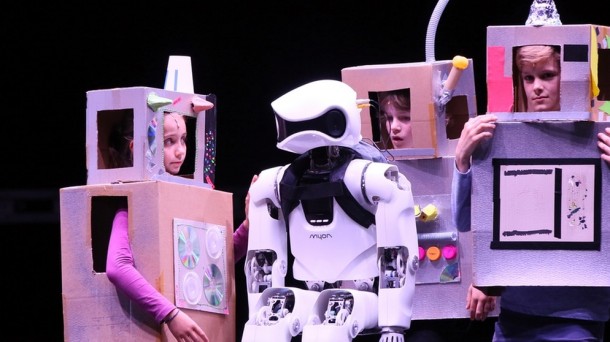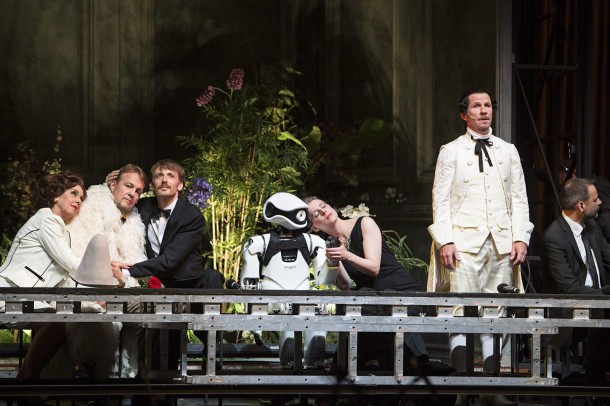What makes us human? What makes a person a person? Can an object ever attain those qualities? Can such qualities be learned, taught, formed? The German-British performance collective, Gob Squad, are not the first to ask these questions, as their not so subtly chosen title, My Square Lady, drawing on Alan Jay Lerner and Frederick Loewe’s famous adaptation of Shaw’s Pygmalion suggests. Yet, the way Gob Squad asks this question is unusual. For their 2015 production at the Komische Oper in Berlin (premiered 21 June 2015), they sought out what, in an opera context, can only be perceived as peculiar collaborators. Together with “Myon,” an autonomous humanoid robot and its team from Neurorobotics Research Labratory at the Beuth Hochschule für Technik Berlin, they try to answer these questions, and stumble on ideas of cyborgization, automatization, and (emotional) manipulation.
At first glance, the story of the operatic experiment is quite simple: the staff from the Komische Oper, from the conductor to the members of the children’s chorus, from the artistic director to the janitor, tries to explain to Myon what makes opera special, so that Myon too can become an opera star. Myon looks a little like a human child. It has two legs, two arms, a head with two ears, and two eyes. But of course Myon isn’t human at all. It is a humanoid robot who specializes in autonomous learning. This means that the robot is not remotely controlled or directed by predetermined algorithms. Everything it does is a “spontaneous” reaction to its surroundings and everything it knows is a product of its self-teaching. Its attention guides what the robot focuses on, takes in, and ultimately learns. At the beginning of the show, Professor Manfred Hild, head of the Neurorobotic Research Lab, explains that emotions decide where this attention is being directed. The task of the opera staff is thus to make their engagement with Myon emotionally capturing enough for the robot to focus its attention on them.

My Square Lady by Gob Squad at the Komische Oper Berlin
Photo credit: Iko Freese/drama-berlin.de.
It’s the site of emotionality that explains Gob Squad’s decision to venture into a new theatrical context for them to produce this work. In their view, opera can be described as a “Kraftwerk der Gefühle” (a power plant or factory of emotion), a place where emotions are produced, evoked, and consumed. Myon is there to learn what it means to feel, express and elicit human emotions. Gob Squad’s performers and the scientists have trained with the robot for eighteen months prior to opening night to ensure that Myon is capable of perceiving—and recalling—when a human being is tense or relaxed or excited. Such behavioral mechanisms are recorded into its memory and can be subsequently retrieved, categorized and replayed. Does this mean it can feel? At second glance, then, the artistic experiment Gob Squad set up was an experiment with the theatre audience, rather than the machine. The robot becomes a vehicle to reflect upon ourselves—the humans in the production—the performers, yes, but more so the audience. The question is no longer a superficial engagement with the question of robots replacing humans in their jobs or imitating human characteristics; it becomes a meditation on the genre of opera when it asks how much we, as audience members are (knowingly) manipulated into feeling in the “power plant of emotion.”
Compared to other humanoid robots, Myon is pretty advanced. Scientifically speaking, it’s a real sensation, having traveled to worldwide conferences for over five years now. Philosophically speaking, it is just shy of giving empirical evidence for free will. But there’s one thing Myon can’t do at all: acting. It can’t take a step by itself, even when sitting on a chair it has to be supported by two assistants to make sure it doesn’t fall over. Thus, the show largely consists of self-contained numbers. One by one the singers of the ensemble around the conductor Arno Washk have a personal moment with Myon (and the audience) in which they share childhood memories, love stories, or the moment they fell in love with opera. These are connected with arias from the operatic repertoire that distinctly encapsulate these emotional experiences for them. At times it feels a little like a best-of opera. Mirka Wagner suffers with Rusalka in “The Song to the Moon” by Dvořák, Carsten Schabrowski rhapsodizes the lost wanderer through Schubert’s “Der Wanderer,” and Christiane Oertel yearns with the “Habanera” from Carmen. Throughout it all, Myon stars, and nods or tilts its head to the songs of love, and life and suffering, which make up the software of the opera. The result is captivating. Myon is a star precisely because it doesn’t do any of the things one would expect from theatre. It does not represent or create any kind of “as-if.” It can only perceive and react.
At one point, Arno Washk tries to teach it to conduct. Myon starts moving its arms up and down. On cue, the orchestra, the ensemble, the chorus and the children’s chorus of the Komische Oper belt out “Brindisi” from La Traviata. As the curtain drops for intermission, one wants to stand up and applaud at this simple play of illusions. Of course, Myon can’t conduct at all. Gob Squad has put all their experience in creating a theatrical situation in this laboratory set-up.
Within the dramaturgy of the performance, this is the moment Gob Squad and the scientists ask what makes Myon different from us, and how Myon, who only listens, only sees, only takes in, can elicit an emotional reaction from the audience. The answer is as simple as it is radical. Myon doesn’t have a human body. Myon doesn’t die. To prove this point, an elaborate scene of resurrection is staged. Invoking the last supper, all the singers are seated behind the table. As two scientist slowly dissemble Myon’s machine body to the left of the table, it is passed piece by piece through the hands of the ensemble, and met by Professor Hild and his assistants at the other side of the table to be reassembled again. Once put back together, Myon takes a tentative step (on the hands of the assistant) to prove that the eighteen months of learning aren’t lost. Myon is still itself, and with this (un-)believable feat, it transcended the human body. On opening night, the steps were awaited in utter silence. Rarely has there been so much dramatic tension in anyone taking a step onstage, nor has it elicited such feelings of awe and uncanniness.
From this point on the dramaturgical arch of the show is clear. Since Myon will “outlive” us all, the performers have to die a dramatic stage death. One by one they tell Myon what they’d like to be remembered for, lie down and “die.” Throughout, Katarina Morfa sings Dido’s lament “When I am laid in earth” by Henry Purcell before she, too, lies still and motionless. As always, Myon listens. Does it have feelings? Is it touched by this moving scenario? That is the wrong question to ask. When Mirka Wagner is asked whether she can cry on demand, she says yes. Christoph Späth (tenor) says no. He can only “believably convey the impression that [he] is crying.” This shows it is not the professionals on stage who experience intense emotions in the theatre. It is us, the audience. And we cry, quite literally “on demand.” We cry “real” tears without any “real” reason.
In her book, Alone Together: Why We Expect More from Technology and Less from Each Other, social psychologist Sherry Turkle stipulates that we are the beginning of the “robotic moment,” where aliveness and real-people interaction have given way to the mimetic representation of such interactions. According to her research, people in the robotic moment are less concerned with the authenticity of an emotional reaction than with their experience of such a reaction itself. The question of whether and how such an experience came about, whether as the result of a genuine interaction, or as a construct of a produced mechanism, then becomes one of secondary importance. In other words, the mechanisms at play in constructing these experiences no longer need to be concealed since, according to Turkle, “the performance of connections seems connection enough” at the robotic moment. In their reader, Gob Squad and the Impossible Attempt to Make Sense of It All, Gob Squad admit that they feel this is a typical human reaction: “We know it’s cheesy, and we know it’s manipulated, but we can’t help crying or feeling touched or romantic when a certain song is being played” (106). When we cry at the opera for nothing, what Myon shows us that night is that we are the machines. In a sense, we are the robots. We are the ones being manipulated and happily so. If Myon really develops feelings in the future, it too will have to cope with this. For now, it turns its head sometimes this way, sometimes that.
is a Ph.D. student at The CUNY Graduate Center. She holds an MA in dramaturgy from the Ludwig-Maximilians University in Munich, where she wrote her thesis on the experience of intimacy in contemporary performance. Clio was awarded IFTR’s New Scholars Prize in 2015, and her essay “‘SHOOT HIM NOW!!!’ Anonymity, Accountability and Online Spectatorship in Wafaa Bilal’s Domestic Tension” has been published in the International Journal of Performance Arts and Digital Media.
European Stages, vol. 6, no. 1 (Spring 2016)
Editorial Board:
Marvin Carlson, Senior Editor, Founder
Krystyna Illakowicz, Co-Editor
Dominika Laster, Co-Editor
Kalina Stefanova, Co-Editor
Editorial Staff:
Elyse Singer, Managing Editor
Clio Unger, Editorial Assistant
Advisory Board:
Joshua Abrams
Christopher Balme
Maria Delgado
Allen Kuharsky
Bryce Lease
Jennifer Parker-Starbuck
Magda Romańska
Laurence Senelick
Daniele Vianello
Phyllis Zatlin
Table of Contents:
- Hamlet in a Curious Nutshell by Maria Helena Serôdio
- Alvis Hermanis Productions in Latvia and German-Speaking Countries by Edīte Tisheizere
- The Unknown, the Unexpected, and the Uncanny: A New Lorca, Three New Catalan Productions, and a Few Extras by Maria M. Delgado
- 2015 Dance Week Festival and Contemporary Croatian Dance by Mirna Zagar
- Archives, Classics, and Auras: The 2016 Oslo International Festival by Andrew Friedman
- The Stakes for City Theatres: Linus Tunström’s Farewell to the Uppsala Stadsteater by Bryce Lease
- Life is Beautiful? or Optimistically About Bulgarian Theatre? by Kalina Stefanova
- The Multiple Dimensions of the Bulgarian ACT Independent Theatre Festival 2015 by Angelina Georieva
- Theatre in Berlin, Winter 2015 by Steve Earnest
- Musical Theatre in Berlin, Winter 2015 by Steve Earnest
- Gob Squad’s My Square Lady at the Komische Oper by Clio Unger
- New Productions in Berlin by Yvonne Shafer
- Manifest for Dialogue: Antisocial by Ion M. Tomuș
- A Fall in France by Heather Jeanne Denyer
- The Iliad as an Oratory: A Warning to a Civilization by Ivan Medenica
- Escaped Alone by Caryl Churchill at the Royal Court Theatre by Rosemary Malague
- Bakkhai at the Almeida Theatre reviewed by Neil Forsyth
Martin E. Segal Theatre Center:
Frank Hentschker, Executive Director
Marvin Carlson, Director of Publications
Rebecca Sheahan, Managing Director
©2016 by Martin E. Segal Theatre Center
The Graduate Center CUNY Graduate Center
365 Fifth Avenue
New York NY 10016



